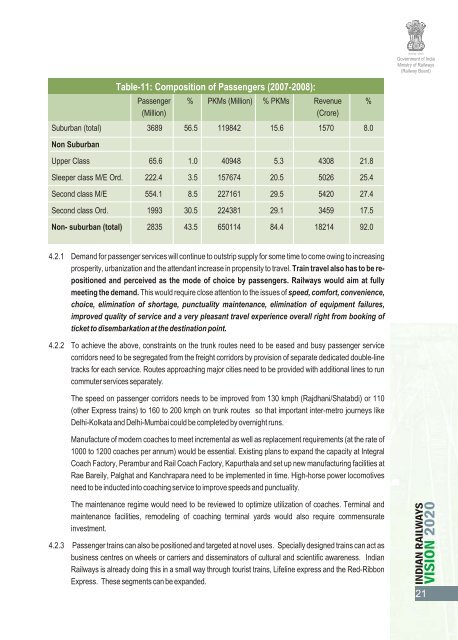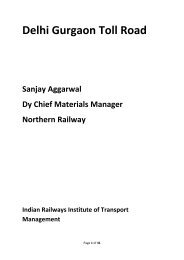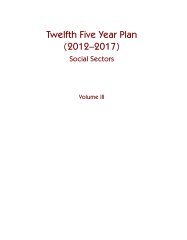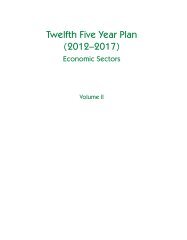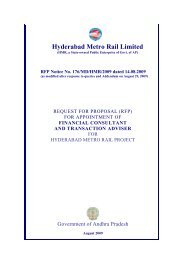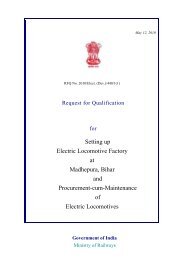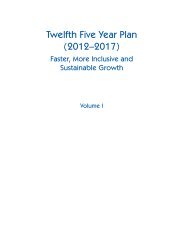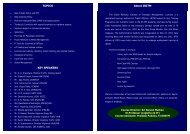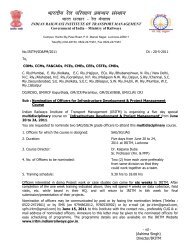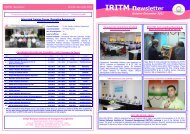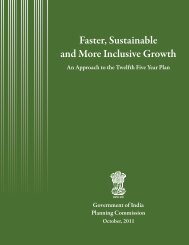Vision 2020 - Transportation Research Group of India
Vision 2020 - Transportation Research Group of India
Vision 2020 - Transportation Research Group of India
You also want an ePaper? Increase the reach of your titles
YUMPU automatically turns print PDFs into web optimized ePapers that Google loves.
Government <strong>of</strong> <strong>India</strong><br />
Ministry <strong>of</strong> Railways<br />
(Railway Board)<br />
Table-11: Composition <strong>of</strong> Passengers (2007-2008):<br />
Passenger % PKMs (Million) % PKMs Revenue %<br />
(Million)<br />
(Crore)<br />
Suburban (total) 3689 56.5 119842 15.6 1570 8.0<br />
Non Suburban<br />
Upper Class 65.6 1.0 40948 5.3 4308 21.8<br />
Sleeper class M/E Ord. 222.4 3.5 157674 20.5 5026 25.4<br />
Second class M/E 554.1 8.5 227161 29.5 5420 27.4<br />
Second class Ord. 1993 30.5 224381 29.1 3459 17.5<br />
Non- suburban (total) 2835 43.5 650114 84.4 18214 92.0<br />
4.2.1 Demand for passenger services will continue to outstrip supply for some time to come owing to increasing<br />
prosperity, urbanization and the attendant increase in propensity to travel. Train travel also has to be repositioned<br />
and perceived as the mode <strong>of</strong> choice by passengers. Railways would aim at fully<br />
meeting the demand. This would require close attention to the issues <strong>of</strong> speed, comfort, convenience,<br />
choice, elimination <strong>of</strong> shortage, punctuality maintenance, elimination <strong>of</strong> equipment failures,<br />
improved quality <strong>of</strong> service and a very pleasant travel experience overall right from booking <strong>of</strong><br />
ticket to disembarkation at the destination point.<br />
4.2.2 To achieve the above, constraints on the trunk routes need to be eased and busy passenger service<br />
corridors need to be segregated from the freight corridors by provision <strong>of</strong> separate dedicated double-line<br />
tracks for each service. Routes approaching major cities need to be provided with additional lines to run<br />
commuter services separately.<br />
The speed on passenger corridors needs to be improved from 130 kmph (Rajdhani/Shatabdi) or 110<br />
(other Express trains) to 160 to 200 kmph on trunk routes so that important inter-metro journeys like<br />
Delhi-Kolkata and Delhi-Mumbai could be completed by overnight runs.<br />
Manufacture <strong>of</strong> modern coaches to meet incremental as well as replacement requirements (at the rate <strong>of</strong><br />
1000 to 1200 coaches per annum) would be essential. Existing plans to expand the capacity at Integral<br />
Coach Factory, Perambur and Rail Coach Factory, Kapurthala and set up new manufacturing facilities at<br />
Rae Bareily, Palghat and Kanchrapara need to be implemented in time. High-horse power locomotives<br />
need to be inducted into coaching service to improve speeds and punctuality.<br />
The maintenance regime would need to be reviewed to optimize utilization <strong>of</strong> coaches. Terminal and<br />
maintenance facilities, remodeling <strong>of</strong> coaching terminal yards would also require commensurate<br />
investment.<br />
4.2.3 Passenger trains can also be positioned and targeted at novel uses. Specially designed trains can act as<br />
business centres on wheels or carriers and disseminators <strong>of</strong> cultural and scientific awareness. <strong>India</strong>n<br />
Railways is already doing this in a small way through tourist trains, Lifeline express and the Red-Ribbon<br />
Express. These segments can be expanded.<br />
21


